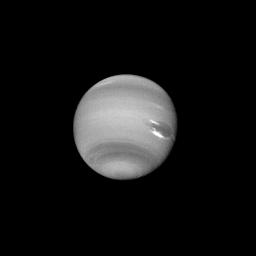
|
Neptune - Dark Feature
- Click the image above for a larger view
- Full-Res JPEG (1000 x 1000) (33.2 kB)
- Full-Res TIFF (1000 x 1000) (137.6 kB)
Caption:
This clear filter image was acquired by Voyager 2 on August 14, 1989, at a range of 14.8 million kilometers (9.2 million miles). The image shows a dark feature extending westward (left) and northward (up) toward the equator from the Great Dark Spot (GDS). This puzzling phenomenon developed over a relatively short period (three rotations or about 54 hours), and continues to evolve with time. Further study may reveal whether this protrusion represents an actual flow of dark cloud material from the GDS or is a result of atmospheric disturbances associated with the western boundary of the GDS. Bright, wispy "cirrus type" clouds are seen overlying the GDS at its southern (lower) margin and over its northwest (upper left) boundary. This is the first evidence that the GDS lies lower in the atmosphere than the bright clouds, which have remained in its vicinity for several months. Increasing detail in global banding and in the south polar region is also apparent.
Background Info:
The Voyager Mission is conducted by the Jet Propulsion Laboratory for NASA's Office of Space Science and Applications.
Cataloging Keywords:
| Name | Value | Additional Values |
|---|---|---|
| Target | Neptune | |
| System | ||
| Target Type | Planet | |
| Mission | Voyager | |
| Instrument Host | Cassini Orbiter | Voyager 2 |
| Host Type | Orbiter | Flyby Spacecraft |
| Instrument | Imaging Science Subsystem (ISS) | |
| Detector | ||
| Extra Keywords | Atmosphere, Grayscale, Rotation, Storm | |
| Acquisition Date | ||
| Release Date | 1999-07-25 | |
| Date in Caption | 1989-08-14 | |
| Image Credit | NASA/JPL | |
| Source | photojournal.jpl.nasa.gov/catalog/PIA01992 | |
| Identifier | PIA01992 | |
